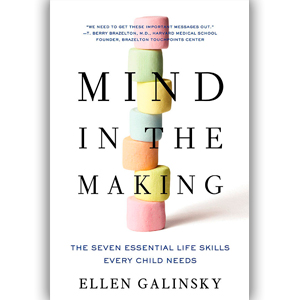Using research to offer parents advice on how to raise well-rounded kids who achieve their full potential, Ellen Galinsky, in her book Mind in the Making, focuses on critical areas that kids don’t just pick up, and therefore, parents need to foster. This book on the seven essential life skills every child needs makes for an informative read on the science of early learning.
Skill One: Focus and Self-Control
“Focus and self-control involve many executive functions of the brain, such as paying attention, remembering the rules, and inhibiting one’s initial response to achieve a larger goal,” explains Galinsky. Furthermore, research from the University of Oregon indicates these skills can be taught. However, Galinsky maintains that in our 24-7 world, which involves endless distractions, the ability to engage in sustained focus, as opposed to multi-tasking, can be extremely difficult but will actually serve your child better in the long run.
What are some of the best ways to promote focus? Galinsky recommends weaving these skills into your everyday life. Play activities, like puzzles, that require children to pay attention. Read stories that encourage children to listen. And realize that background noise, such as a television, disrupts children’s play.
Skill Two: Perspective Taking
According to Galinsky, perspective taking requires inhibitory control, cognitive flexibility, and reflection. While rarely on lists of essential skills, Galinsky argues it should be, using research from the University of California and MIT to show its importance. Galinsky maintains, “Perspective taking involves the intellectual skill of discerning how someone else thinks and feels; it requires assembling our accumulated knowledge of that person, analyzing the situation at hand, remembering similar situations, recalling what others have told us about such situations, putting aside our own thoughts and feelings, and trying to feel and think as another person must feel and think.”
How can you promote perspective taking in children? Galinsky believes one of the first steps is parents viewing teaching children to be with others as equally important to teaching them to be independent. The easiest way to do this is to use everyday moments as opportunities to talk. Galinsky points out that research shows that while parents often think children learn from ‘instruction’ the reality is that children learn by watching their parents. So be sure to practice what you preach.
Skill Three: Communicating
While Galinsky believes children are born primed to communicate, parents play an important role in children’s language and literacy development. She writes how parents need to understand it’s about developing an understanding of how to communicate verbally and in writing, as opposed to neglecting children’s comprehension in favor of skill and drill. The process should be as enjoyable as possible and, Galinsky claims, parents should do everything they can to create an environment at home where words, reading, and listening are important.
How can you promote communicating with your children? Galinsky writes parents should start by remembering the purpose of language, narrating your children’s experiences early on and helping them record their experiences later in life. According to Galinsky, “Learning is powerfully enhanced when children and parents pay attention to the same thing.” This is why reading to your children is so important. It offers families the opportunity to talk about this shared story.
Skill Four: Making Connections
Making connections begins with sorting and categorizing, explains Galinsky, to the ‘aha’ moment, when children suddenly understand what previously evaded them. While this chapter of Mind in the Making focuses a lot on how children develop their object and space sense, it sets the stage for when children literally pull it all together. For example, connections between a child’s prior experience and a text she is reading can affect how well she comprehends what’s she’s read. (The book Mosaic of Thought by Ellin Oliver Keene and Susan Zimmerman is a great resource for understanding the connections children make when they read.)
The best way to promote learning on the deepest level, according to Galinsky, is to tap into your child’s passion and encourage them to play creatively. By giving your child specific feedback on their thinking and helping them see things in different ways, Galinsky claims to will help children see the possibilities for future connections.
Skill Five: Critical Thinking
“At its core, critical thinking is the ongoing search for valid and reliable knowledge to guide our beliefs and actions,” explains Galinsky. Since critical thinking draws on all skills previously mentioned, it plays a crucial role in a child’s success. Helping your child understand what’s valid and reliable knowledge is important because, as Galinsky argues, it lets them know when they need to turn to others for information and enables them to discern who best to help them.
How can you promote critical thinking in your children? Try to avoid jumping in too quickly, as Galinsky states it stunts children’s curiosity and prevents them from gaining experiential knowledge. Parents should also encourage their children to pursue their own ventures, be it setting up a lemonade stand, or in my daughter’s case starting a twisty bands bracelet business. These experiences allow children to evaluate information and revise their actions accordingly. Ultimately, Galinsky believes every child needs a metaphorical lemonade stand, as “caring strongly about interests beyond oneself engenders true focus.”
Skill Six: Taking on Challenges
Stress is becoming more and more of a factor in our children’s lives. One of the reasons this is happening is because, as Galinsky notes, kids sense when their parents feel overwhelmed. She writes, “39 percent rated their parents as frequently stressed.”
According to Galinsky, the biggest thing parents can do to help promote their children taking on challenges is manage their own stress. Galinsky recommends you tell your children directly that you’ve had a bad day, as “most know it anyway from reading the nonverbal language of your behavior.” Then, she suggests your share how you are going to cope with the situation. This way, Galinsky explains, your kids see the whole picture and are better prepared when challenges on their way.
Skill Seven: Self-directed, Engaged Learning
Galinsky explains, “Carol Dweck of Stanford University has found that children who avoid challenges have a fixed mindset…whereas children who are willing to take on challenges have a growth mindset, seeing their abilities as something they can develop.” It probably wouldn’t surprise you to learn that children with the growth mindset do better in school and ultimately life.
The Mind in the Making ends with Galinsky stressing that we teach best when we are learning. “In study after study that my organization has conducted on parenting or on early education, we arrive at similar findings,” she notes. “Adults who continue to learn about children – about parenting them and teaching them – make the best parents and the best teachers.”
So hopefully, you’ll recognize what Galinsky points out in the end of her book. None of these skills require expensive programs, fancy materials, or elaborate equipment – just a willingness, she explains, “for doing everyday things you do with children in new ways.” After all, Galinsky makes it clear that being a parent not only means your children will learn from you for the rest of their lives, but you them.
Follow @ParentbytheBook on Twitter for updates on blog posts or like Parenting by the Book on Facebook.





